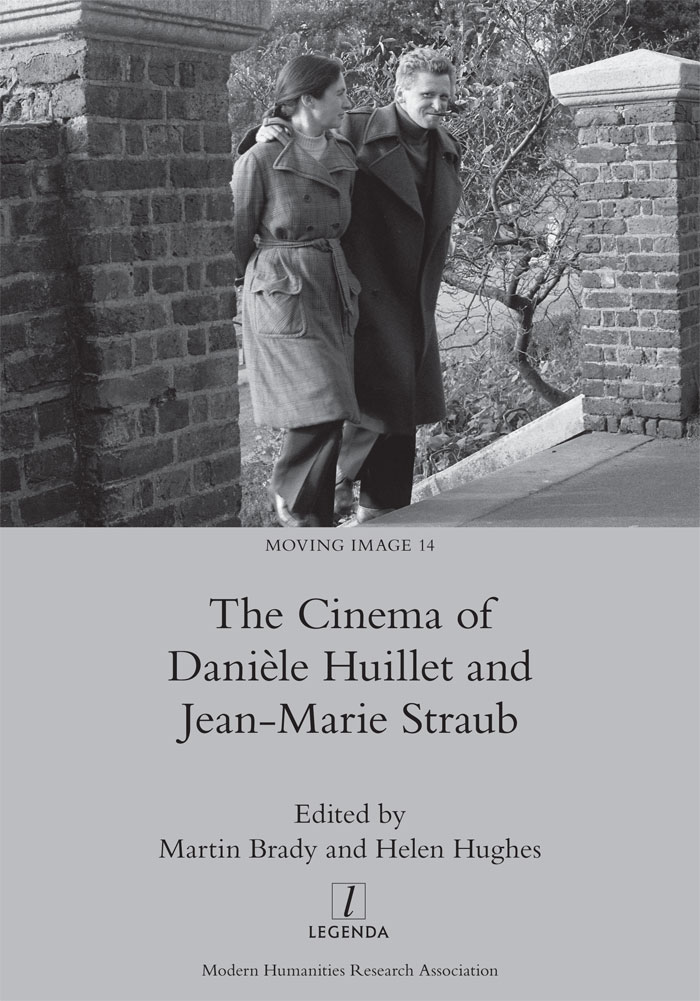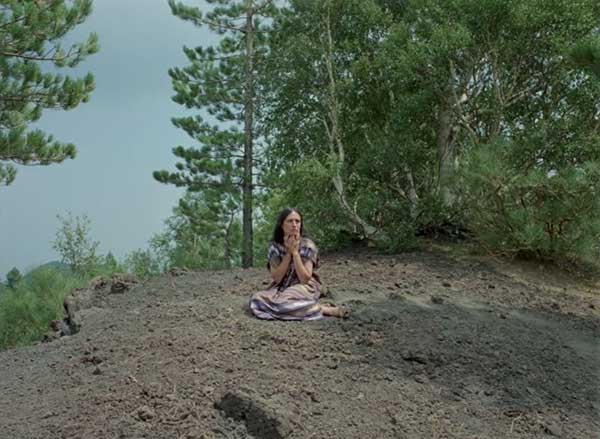Tiger-Leaps Into the Past
Barbara Burns talks to Martin Brady and Helen Hughes, co-editors of The Cinema of Danièle Huillet and Jean-Marie Straub which recently appeared in Legenda’s Transcript series.

BB. Danièle Huillet and Jean-Marie Straub were a remarkable filmmaking duo. They made films in French, German and Italian that were politically radical and controversial, and that challenged the conventional commercial model. What attracts you to their work, and why is its legacy so important?
HH. Huillet’s and Straub’s work is probably the most radical body of political cinema since 1945. And the most consistent and recognisable too! Remarkably, their approach is already fully developed in their first short film of 1963 (Machorka-Muff), an adaptation of a short story by the German writer Heinrich Böll satirizing West German rearmament and the legacy of Nazism. As works of political modernism, heavily indebted to Bertolt Brecht, their films can be situated alongside the more famous oeuvre of Jean-Luc Godard and Anne-Marie Miéville, although Huillet and Straub didn’t go through different phases or experiment with new technologies and genres in the same way as their Swiss/French compatriots.


As Marxists, Huillet and Straub remained politically and stylistically committed across fifty or more films to a particularly rigorous kind of appropriation of the cultural heritage – of prose, drama, poetry, music, and painting – to reveal the fissures, contradictions and injustices of contemporary society. That may sound severe or ascetic, and their films can be that as well, but they are also beautiful, profoundly humane, and often very funny, as in their absurdist adaptation of a short story of Marguerite Duras about a boy who refuses to learn what he doesn’t already know (En rachâchant, 1983), their adaptation of Franz Kafka’s novel Amerika (Class Relations, 1984), and their wonderfully lively and energetic staging of Arnold Schoenberg’s comic opera Von heute auf morgen in 1997. And talking of innovation, the Schoenberg film is still the only fully live opera film ever made, ‘a revolution in the history of opera films’, as one commentator has put it.
BB. You highlight the fact that critical responses to Huillet and Straub’s cinema have employed the rhetoric of ignition and explosion. Can you explain why these terms are so pertinent?
MB. Modernism, especially of the political kind, was surely always meant to be explosive, to upset the lazy and challenge the status quo! In the case of Huillet and Straub there’s a direct precedent for the rhetoric of political and artistic dynamite in the writings of the German philosopher Walter Benjamin, someone the directors were fond of quoting. He described in his famous late essay on history and revolution – ‘Theses on the Philosophy of History’ of 1940 – how the seemingly inexorable forward movement of history-as-catastrophe needs to be exploded apart. The shards and splinters of that history can then be reassembled in exciting and unexpected ways to offer new perspectives and opportunities for revolutionary change.
Benjamin’s essay is being quoted a lot these days, be it at the Marxism 2023 festival in London or on Radio 3’s ‘Private Passions’, as people recognize the need for radical social, political and ecological change. What Benjamin in the notes for his essay nicely calls applying the ‘emergency brake’. That’s what the films of Huillet and Straub do!

BB. Was Huillet and Straub’s cinematic work well received? Did audiences understand what they were trying to achieve, or were the films perceived as being too austere and intellectual?
MB. In the seventies, someone coined the term ‘Godard-Straub’ cinema for radical political filmmaking, and quite a few people ran with it, especially in the lively debates in the famous UK film journal Screen. Regrettably sexist as the term undoubtedly was – in omitting Huillet and Miéville of course – it has had a lasting resonance. Yes, the films are certainly challenging, but difficulty is a good thing, isn’t it? As the East German composer Paul Dessau put it, difficulty is what makes things interesting: ‘thinking is famously uncomfortable... we have to do a lot of things that are uncomfortable. Building Socialism isn’t comfortable.’
BB. How did your book come about?
HH. The book is a product of enthusiasm. In fact, that could have been its title if it hadn’t already been used for a special issue journal on their work in 1975. It was also a suggestion for the title of the 2019 retrospective in London out of which the book evolved. Ricardo Matos Cabo, working in collaboration with the Goethe-Institut London, curated a full retrospective across four months with workshops, discussions and so forth. It was an unexpected success, especially for the BFI who had feared that it might be ‘box-office poison’. Thousands of tickets were sold and a hard-core of loyal fans and filmmakers attended dozens of screenings. Lots of us kept meeting up again and again at the events, and out of this enthusiasm the book was born.
We met up as a group a couple of times after the retrospective, before we were cut short by the Covid-19 pandemic. Then, thanks to the suggestion of the then-editors of the Moving Image series Erica Carter and Emma Wilson, we approached Legenda. The Managing Editor Graham Nelson and new series editor J. D. Rhodes were very supportive from the outset. Enthusiasm always helps! Graham was a bit perplexed when we sent him an 8.5 MB .tif file of a completely white screen from Straub’s wonderful late Kafka film Jackals and Arabs (2011). He rightly suggested a single bit of data would look exactly the same, but he generously agreed to indulge our materialism! Readers can find it on page 193.
BB. All of Huillet and Straub’s films are based on literary works and political writings, for example by Kafka, Brecht, Böll, Vittorini, Pavese. What kind of adaptations should the new viewer expect?
HH. This is a great question, but one which you just can’t answer briefly, which is why we spent a lot of words addressing it in our introduction! Their films are certainly not adaptations in the conventional sense; they are engaged, political readings of classic and neglected texts for the present. You could say their films are as much about books, music or paintings as adaptations of them.

BB. Danièle Huillet and Jean-Marie Straub were a husband-and-wife partnership who made many films together over a 40-year period, yet Huillet seems to be in her husband’s shadow to some extent. Why do you think that is the case, and is this imbalance something you sought to address in your study?
MB. As we mentioned, this is equally true of Anne-Marie Miéville working with Godard, despite the fact that ‘his’ films changed hugely when the pair started working together in the early 1970s. It’s obviously a phenomenon you find everywhere. Elfriede Fischinger, wife and collaborator of the German experimental filmmaker Oskar Fischinger, who in exile from Nazi Germany briefly worked with Disney (on Fantasia no less), once sardonically noted in a TV interview that ‘wives never get the credit’! But things are changing, and Huillet fortunately comes before Straub alphabetically.
In the case of this collaboration, it is sadly the case that Huillet died sixteen years before her husband, but even after that, when working solo, Straub co-credited later films that had begun life as joint projects. And what’s more, we have transcribed and translated a wonderful interview with the pair at the Goethe-Institut London in 1990 and you will see that she has at least as much to say as he has, not least because her English was a bit more idiomatic than his. Straub was, ultimately, the more flamboyant, outgoing and provocative personality, but the work was always completely collaborative, from the outset.
BB. In what ways does the mix of contributors to your book, which includes both Film Studies specialists and filmmakers, enrich its scope?
HH. The diversity of the contributors was one of the challenging aspects, and at the same time, for us, this was the great strength and excitement of the project. The authors are research students, filmmakers, curators, translators, academics across a wide range of disciplines. This isn’t simply a volume of film history, but an affirmation of the lasting relevance and inspiration of Huillet and Straub’s work.
Straub released a new film as we were putting the collection together – France Against Robots (2020, still officially available on YouTube) – so this was always a book about living and breathing cinema. Sadly, Straub died as the volume went into print, which now means it will be the last about their work as contemporary filmmakers. But there are contributors to this volume, such as Rastko Novaković, who are keeping political modernist filmmaking in the tradition of Huillet and Straub alive.
BB. Have Huillet and Straub’s films stood the test of time in the sense of attracting fresh audiences as well as scholars?
MB. Interesting question. Of course, the films aren’t screened or engaged with enough in our opinion – no surprise there perhaps! – but there is a simple reason for that: hardly any of them are available with subtitles. Without them, you need to speak German, French and Italian. There are roughly equal numbers of films in those three languages. Just one 2-DVD set is currently available in the UK containing the wonderful Elio Vittorini-adaptation Sicilia! (1999), the famous Bach film Chronicle of Anna Magdalena Bach (1968) and a Cézanne documentary (A Visit to the Louvre, 2004).
But there’s good news there. The Huillet and Straub legacy is in the very safe hands of Straub’s second wife Barbara Ulrich, and digitization and subtitling is taking place as we speak. Many more films should become available in high-quality restorations in the coming years for people to discover and appropriate creatively through tiger-leaps into the past, as Walter Benjamin famously put it.

full news feed • subscribe via RSS